Required Equipment for Therapeutic Back Massage:
- Warm, quiet, relaxed environment.
- Firm comfortable surface such as a (firm) bed, massage table or floor mat.
- Massage Oil. Baby oil will do fine for a starter.
- Towels: to lie on, and also to cover the body.
- Cushions or pillows.
|
The Back Maintenance Manual - for Lower Back Pain
Learn more!

|
Massage Tips:
- Massage oil decreases the friction created on the skin and prevents the pulling
of hairs. Don't use too much: The less oil, the greater the friction and the
deeper the pressure.
- Use slower movements for a soothing or calming response.
-
When applying pressure with finger or thumb, provide support with the other fingers
and thumbs. Otherwise you will wear your thumbs out!
Massage Patient Comfort:
-
If the patient is uncomfortable in the lower back, ankles, neck or shoulders,
place cushions as required under the whole length of the torso, and/or under the ankles,
the shoulders, or the side of the head (diagram right). In pregnancy, the patient can lie on
her side. Do not use the massage techniques in this article during pregnancy (not gentle enough).
Try the following article at 101lifestyle.com :
Massage In Pregnancy: A Step by Step Guide
|

|
-
Cover any parts of the body not being worked on with a warm towel.
-
Pour the massage oil onto your hands first, and then apply (too cold otherwise!)
Once the massage is started, keep a hand on the person at all times, so that there
are no surprises.
-
Avoid direct pressure on bony processes.
- (Important!) -
Ask the patient for feedback: Are you warm enough? Are you comfortable? How's that feel?
|
Massage Warnings:
- Minimal direct pressure on bony processes.
- Avoid broken skin, blisters or areas of possible infection.
- See also Back Pain Red Flags
Massage Benefits:
- Relaxation, releasing of tight muscles.
- Emotional comfort and stress management.
- Increased body awareness.
- Improved circulation, and
improved lymphatic drainage for release of toxins.
Therapeutic Back Massage Technique Tips:
Lie the partner on their belly on a firm, comfortable surface (see diagrams below).
Make sure you can reach their whole back without straining your own.
Back Massage Technique, Tip 1:
Whole Hand Effleurage
|
Warm the massage oil in your hands, and apply a modest amount (see tips, above )
with whole hand "effleurage" (definition - smooth rhythmic stroking): Use the
whole surface of both hands (see diagram). Stroke reasonably firmly upwards from
the lower back all the way up to the neck, then (gentler pressure), circle
around and back to the lower back region (5 to 10 minutes).
|
|
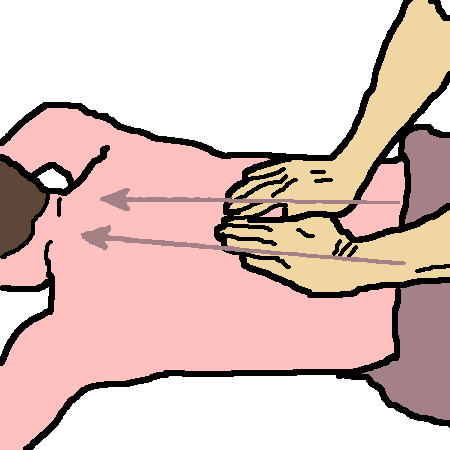

|
|
Back Massage Technique, Tip 2:
Effleurage using Heel of the Hand
|
There is a smaller area of contact, so the pressure is deeper.
Both hands work in circles - start at the lower back. Move in a circle,
first outward, then upward and return to the center. Gradually progress to the
upper back (5 minutes).
|
|
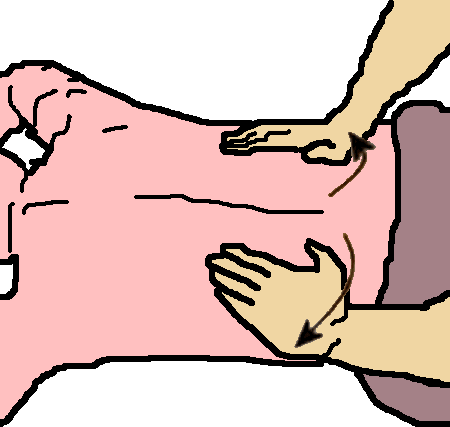
|
|
Back Massage Technique, Tip 3:
Effleurage using reinforced Fingers
|
(Smaller area of contact, so deeper again - see diagram).
Stand on the opposite side to the one that you are working on. I suggest you stand on the right side first.
Push with the flats of
your fingers (one hand on top of the other) away from the center line,
then glide back toward the spine. Start at the lower back, and work up to the upper back (five minutes).
|
|
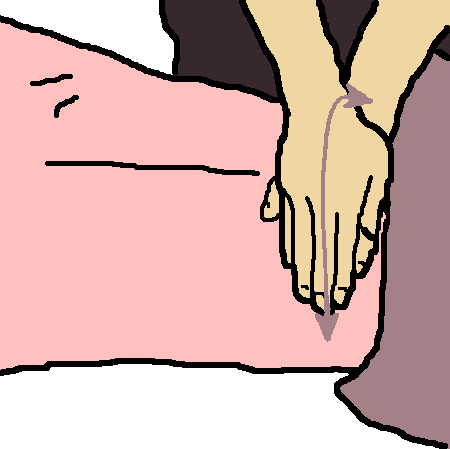
|
|
Back Massage Technique, Tip 4:
Stripping, using the Reinforced thumb
|
Glide with deep sustained pressure up the full length of the "sausage shaped"
muscles either side of the spine (see diagram). Back off the pressure a little as you cover
the neck. Move slowly and deliberately, feeling for knots or sensitive spots
as you glide from lower to upper back. Three times each side; alternate with a couple of minutes of effleurage
(techniques one to three above), and repeat the stripping.
|
|
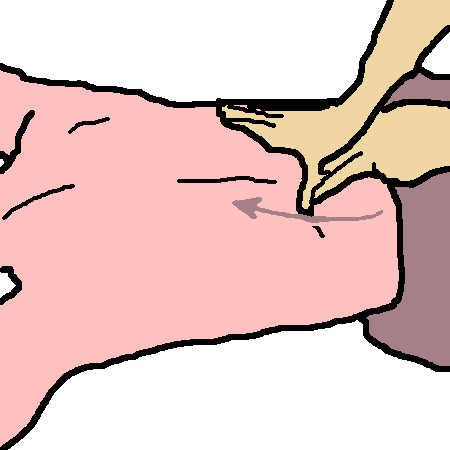
|
|
Back Massage Technique, Tip 5:
Frictions, using the Reinforced Middle Finger:
|
Firm
deep movements either side of each spinous process. Start to the side of the lower
spine and move upward. Apply 5 frictions at each spot - more if over a sore spot.
|
|
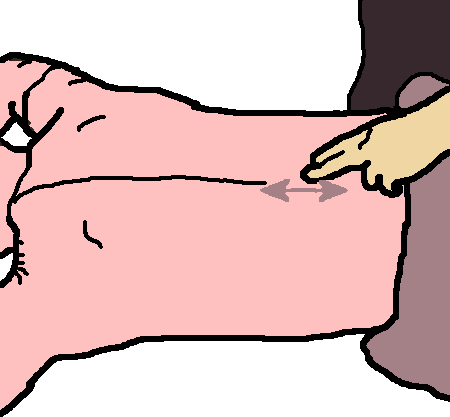
|
|
Back Massage Technique 6:
"Effleurage" using Forearms
|
Apply firm
downwards pressure (see diagram), and move the arm closest to the head up to just below the shoulder blades.
6 strokes. For the first stroke, be aware of the possibility of lower back pain
|
|
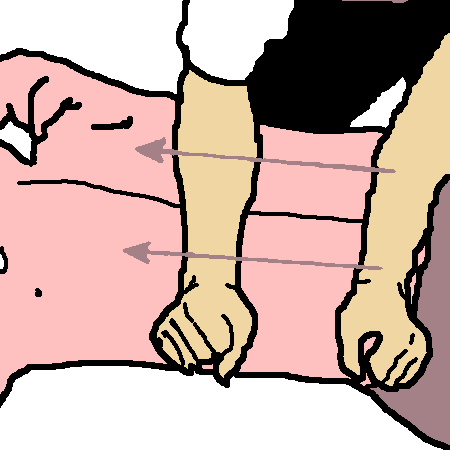
|
|
Back Massage Technique, Tip 7:
Trigger point release using sustained pressure of the
of the reinforced thumb.
|
Let the patient's pain be your guide. Place your
thumb over any tender spots or knots that your patient may have told you about or that you may have felt,
and press firmly and with increasing pressure thus:
Gradually increase the pressure until the pain is 6 or 7 on a scale of one to
ten. Hold that pressure until the pain lowers to about 4/10 (takes about 5 seconds).
Immediately (don't stop the pressure), increase again until the pain is 6 to 7
on the scale of 10, and again hold until the pain subsides to 4/10.
Repeat step two.
This is painful, but you can't do much harm to the patient - quite the reverse:
muscle and back pain (upper or lower)may miraculously disappear. Your thumb is more likely to
suffer, so make sure that you back it up with the fingers of the other hand, and
after each trigger point release, give your thumb a bit of massage too.
|
|
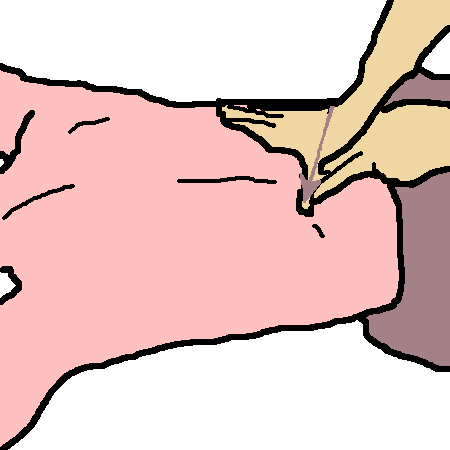
|
|
Back Massage Technique, Tip 8:
Finishing with Effleurage
Apply effleurage (stroking moves) with supported fingers
(technique 3 above), then effleurage with the heel of the hand (technique 2 above),
then full handed effleurage (technique 1 above). This will enhance the good that
you have done with the stripping and trigger point release. Then leave the patient quiet for a few minutes.



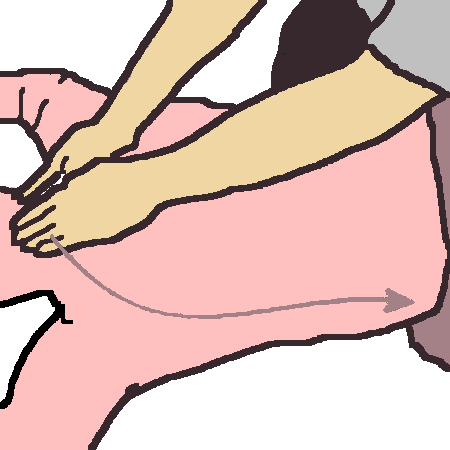
|
Patient Advice:
For the five days after the massage, encourage the patient
not to sit, stand still or run, for longer than half an hour at a time; but rather to take a
short walking break, and to sip water frequently.
Back Pain Red Flags
If your massage patient has back pain (upper or lower) related to any of the following, refer
them to a medical specialist. See also:-
Back Pain Red Flags
- Younger than 20 or older than 55 and getting back pain for the first time.
- Pain after a violent injury, e.g. road traffic accident.
- Pain is constant and getting worse.
- Pain is in the upper part of the spine.
- Cancer in the past or at present.
- Taking (Cortico)steroids.
- Drug abuser, or HIV infected.
- Generally unwell or feverish.
- Significant weight loss.
- Continue to have great difficulty bending forwards.
- Nerve related problems other than pain: loss of sensation (especially of the
area that would sit on a saddle - so called saddle anaesthesia), loss of power,
urinary or bowel incontinence.
- Obvious structural deformity of your spine.
- Debilitating pain that is not reducing after 4 -6 weeks.
| |
|